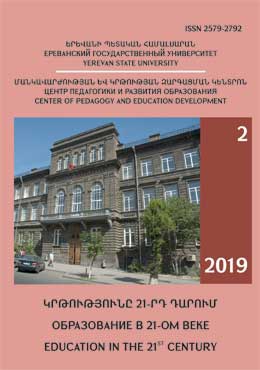TO THE PROBLEM OF STUDYING THE VISUAL PERCEPTION OF STUDENTS WITH LOW VISION WITHIN THE SCOPE OPTICAL AND GRAPHICAL WRITING DISORDERS CORRECTION AND PREVENTION
DOI:
https://doi.org/10.46991/educ-21st-century.v2i2.10787Keywords:
visual impairment, visually impaired children, optical-graphic writing disorders, research, correction, prevention, visual perceptionAbstract
The article analyzes the results of the studies on the formation and development of visual perception of visually impaired children in the aspect of correction and prevention of optical-graphic writing disorders, conducted by foreign and domestic authors. First of all, the importance of the problem is determined by the fact that the visual impairment makes the process of reading and writing of these children much more difficult. Owing to the insufficient development of visual perception, visually impaired students write letters, syllables or words together or excessively apart, dislocate the writing straightness etc.
Therefore, the correction and prevention of this kind and other optical-graphic writing dislocations of visually impaired students has utmost importance.
Тhe special scientific and methodological literature pays great attention to the issues connected with the formation and development of visual perception of children with visual impairment in, many foreign and domestic researchers do research in this field.
However, conducted works lack due attention to the development of visual perception of visually impaired children within the scope of correction and prevention of optical-graphic writing disorders. Whereas the solution to this problem is very important for these children.
Therefore, the question to explore the ways and means of creation and development of techniques of visual perception, reading of flat surfaces, the correction of optic-graphic writing skills of children with visual impairment has an important significance for the theory and practice of teaching the students in special, inclusive and mainstream schools.
The above stated determines the relevance of this study, its theoretical and practical significance.
References
Список использованной литературы
Аветисов Т.Ц., Охрана зрения у детей // «Медицина», М., 1975. – 272 с.
Азарян Р.Н., Григорян Н.П., Коррекционно-развиваюшая робота со слабовидяшими детьми в условиях массового и интегративного обучения // «Педогагическая мысль» 2009, N1-2. – с.157-160.
Беляцкая В.И., Гнеушева А.Н., Охрана зрения слабовидящих школьников, -М., 1982. – 127 с.
Ермаков В.П., Специальное образование лиз с нарушением зрения. В кн. Спе¬циа-льная педагогика /Под пер. Н.М. Назаровой. – М. 2010. – с. 279-300.
Земцова М.И., Учителю о детях с нарушением зрения, – М, «Просвешение»1973. –59 с.
Психолого-педагогическая характеристика детей с нарушением зрения. В. Кн. Специальная педагогика /под ред. Л.В Мардахаева, Е. А.Орловой. М, 2012. – С. 121-134.
Слабовидяшие дети/под ред. Ю.А. Кулагина, Н. Г. Морозовой, М.Б Фидиновой. «Просвещение». – М., 1967. – 250 с.
Тупоногов Б.К., Учëт офтальмологических рекомендаций при организации учебно- воспитательной работы с детьми имеюшие зрительный дефект //Дефектология, 1998, N5. – с. 58-63.
Zejmis M., SosialCampaigns for visually impaired people in Poland. –Warszawa: Academy of special Education Press, 2007, p.180-194.
Ntuli E., Traore M., A study of shananion, Early childhood Teaches perceptions about inclusive Education / The journal of the international Association of special Education , 2013, vol 14, N1, p. 50-58.
Downloads
Published
How to Cite
Issue
Section
License

This work is licensed under a Creative Commons Attribution-NonCommercial 4.0 International License.

